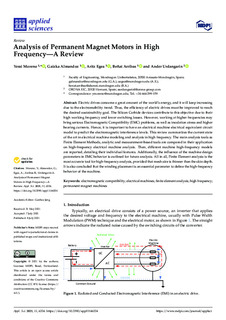Título
Analysis of Permanent Magnet Motors in High Frequency: A ReviewAutor-a (de otra institución)
Fecha de publicación
2021Grupo de investigación
Accionamientos aplicados a la tracción y a la generación de energía eléctricaOtras instituciones
Orona EICVersión
Version publicadaTipo de documento
ArtículoArtículoIdioma
InglésDerechos
© 2021 by the authors. Licensee MDPIAcceso
Acceso abiertoVersión de la editorial
https://doi.org/10.3390/app11146334Publicado en
Applied Sciences. Vol. 11. N. 14. N. artículo 6334, 2021Editorial
MDPIPalabras clave
electromagnetic compatibility
electrical machines
finite element analysis
high frequency ... [+]
electrical machines
finite element analysis
high frequency ... [+]
electromagnetic compatibility
electrical machines
finite element analysis
high frequency
permanent magnet machines [-]
electrical machines
finite element analysis
high frequency
permanent magnet machines [-]
Resumen
Electric drives consume a great amount of the world’s energy, and it will keep increasing due to the electromobility trend. Thus, the efficiency of electric drives must be improved to reach the desire ... [+]
Electric drives consume a great amount of the world’s energy, and it will keep increasing due to the electromobility trend. Thus, the efficiency of electric drives must be improved to reach the desired sustainability goal. The Silicon Carbide devices contribute to this objective due to their high working frequency and lower switching losses. However, working at higher frequencies may bring serious Electromagnetic Compatibility (EMC) problems, as well as insulation stress and higher bearing currents. Hence, it is important to have an electrical machine electrical equivalent circuit model to predict the electromagnetic interference levels. This review summarizes the current state of the art in electrical machine modeling and analysis in high frequency. The main analysis tools as Finite Element Methods, analytic and measurement-based tools are compared in their application on high-frequency electrical machine analysis. Then, different machine high-frequency models are reported, detailing their individual features. Additionally, the influence of the machine design parameters in EMC behavior is outlined for future analysis. All in all, Finite Element analysis is the most accurate tool for high-frequency analysis, provided that mesh size is thinner than the skin depth. It is also concluded that the winding placement is an essential parameter to define the high-frequency behavior of the machine. [-]
Sponsorship
Gobierno VascoID Proyecto
GV/Programa predoctoral de formación del personal investigador no doctor 2020-2021/PRE_2020_1_0229/CAPV//Colecciones
- Artículos - Ingeniería [761]
El ítem tiene asociados los siguientes ficheros de licencia:






















